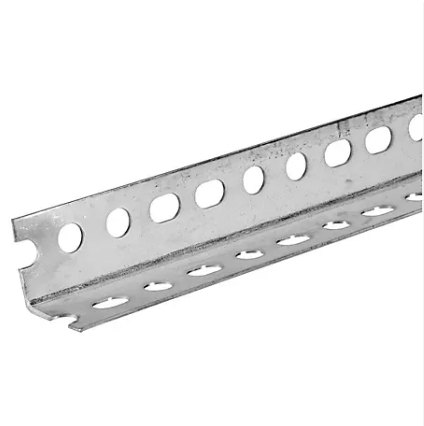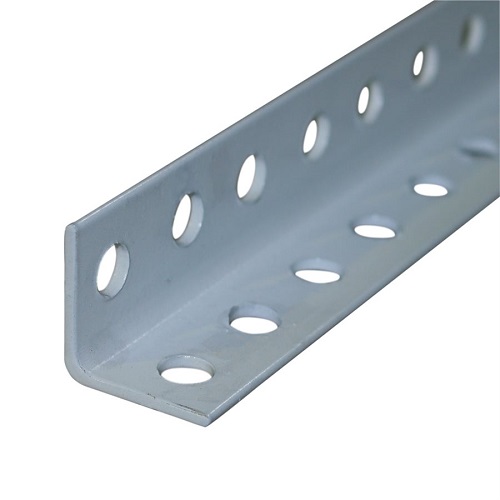When it comes to construction and DIY projects, having the right materials can make all the difference. One such essential component is the metal angle with holes,such as steel angle. This versatile piece of hardware offers numerous benefits, making it a favorite among builders and hobbyists alike. In this article, we'll explore the various uses, benefits, and types of metal angles with holes, providing you with a comprehensive guide to this indispensable material.
A metal angle with holes is a piece of steel or aluminum shaped into a right angle, typically 90 degrees, with pre-drilled holes along its length. These holes allow for easy fastening and attachment to other materials, making it an incredibly versatile component in various construction and assembly applications.
What materials are the holes of the punched angle iron connected to?
Whether you're working on a large-scale construction project or a small DIY task, these slotted angles can provide the support and stability you need.
(1)Slotted Angle Iron
This type features elongated slots rather than circular holes, providing more flexibility in positioning and fastening.This type of angle steel features elongated slots that are evenly distributed. These slots provide a standardized positioning, ensuring that connecting components can be precisely aligned, which enhances the overall stability and safety of the structure.
(2)Perforated Angle Iron
With evenly spaced holes, this type is ideal for uniform fastening and support.To meet various demands, the holes in perforated angle steel come in shapes such as circular, square, rectangular, oval, diamond, and other forms. The shape of the holes is typically determined by their intended use, the type of fasteners required, and the specific requirements of the structural design.
(3)Pre-Drilled Angle Iron
As the name suggests, this type comes with pre-drilled holes, ready for immediate use without the need for additional drilling.Each type has its unique benefits and is suited to different applications, so it's important to choose the right one for your specific project needs.

3.Benefits of Using Metal Angles with Holes
Using slotted steel angle offers several key advantages:
(1)Ease of Installation
The pre-drilled holes make it simple to attach the angles to other materials, saving time and effort.
(2)Versatility
These metal angles can be used in a wide range of applications, from constructing frames and supports to reinforcing structures and creating custom brackets.
(3)Strength and Durability
Made from sturdy materials like steel or aluminum angle, these angles provide reliable support and long-lasting performance.
(4)Adjustability
The holes or slots allow for adjustable fastening, making it easy to customize the fit and alignment during installation.
The versatility of perforated steel angle means they can be used in a variety of settings, including:
(1)Construction
From framing and reinforcing structures to creating custom supports,
metal angle iron with holes are a staple in construction projects.
(2)Shelving and Storage
These angles are often used to create robust shelving units and storage solutions, thanks to their strength and easy assembly.
(3)DIY Projects
Hobbyists and DIY enthusiasts use punched angles for everything from building furniture to crafting garden structures and home decor.
(4)Automotive and Machinery
In the automotive industry, these angles can be used for mounting components, creating custom brackets, and reinforcing frames.
When selecting a metal angle with holes for your project, consider the following factors:
(1)Material
Steel is typically stronger and more durable, while aluminum is lighter and more resistant to corrosion.
(2)Size and Thickness
Ensure the angle is the right size and thickness for your specific application to provide adequate support.
(3)Hole Pattern
Choose between slotted, perforated, or pre-drilled options based on your fastening needs and desired flexibility.
Conclusion
A metal angle with holes is an essential component in many construction and DIY projects, offering versatility, ease of use, and reliable strength. By understanding the different types and their applications, you can choose the right metal angle to suit your needs and ensure the success of your project.
For further information and to purchase high-quality metal angles with holes, consider reputable suppliers such as Nansteel Manufacturing Co.,Ltd, we offer a wide range of options and expert advice to help you find the perfect solution for your construction needs.
By integrating these versatile tools into your projects, you can achieve professional results with greater ease and efficiency.
1.What is a Metal Angles with Holes?
Punching angle steel is a common building material, usually used to build supporting structures or connecting components. It is made of cold-rolled or hot-rolled angle steel through punching, and has high strength and stability.A metal angle with holes is a piece of steel or aluminum shaped into a right angle, typically 90 degrees, with pre-drilled holes along its length. These holes allow for easy fastening and attachment to other materials, making it an incredibly versatile component in various construction and assembly applications.
What materials are the holes of the punched angle iron connected to?
| Connection Type | Material | Description |
|---|---|---|
| Bolts and Nuts | Metal | Bolts pass through the holes and are secured with nuts to connect components. |
| Welding | Metal | Perforated angle steel can be connected to other metal parts through welding. |
| Clamps and Brackets | Metal | U-bolts, angle brackets, etc., are fixed onto the perforated angle steel via holes. |
| Metal Sheets | Steel/Aluminum | Sheets like steel or aluminum plates are fastened onto the angle steel using self-tapping screws or bolts. |
| Pipes and Tubing | Various | Used to secure piping systems in structures like support brackets or frames. |
| Cables and Wires | Electrical | Perforated angle steel is used to secure cable trays or conduits in electrical installations. |
| Plastic Accessories | Plastic | Certain plastic connectors or fasteners can be used in conjunction with perforated angle steel. |
| Wood | Wooden | In some applications, perforated angle steel can be used to connect or support wooden structures. |
Whether you're working on a large-scale construction project or a small DIY task, these slotted angles can provide the support and stability you need.
| Feature | Description |
|---|---|
| Structural Rigidity | High bending and torsional rigidity allows it to withstand significant loads without deformation. |
| Geometric Stability | The L-shaped cross-section naturally provides stability and effectively resists pressure. |
| Connectivity | Holes facilitate connections with bolts, screws, or other fasteners, forming stable structures. |
| Ease of Installation | The presence of holes simplifies the attachment process, making construction more efficient. |
| Versatility | Perforated angle steel can be customized in size, thickness, and hole pattern to suit various support needs. |
| Load-bearing Capacity | Designed to handle high loads, especially when combined with other structural elements through welding or bolting. |
| Corrosion Resistance | Often galvanized or coated, which enhances its durability and resistance to environmental factors. |
| Economical | Generally cost-effective compared to other support materials, making it an economical choice. |
| Customizability | Can be tailored with specific hole sizes, spacing, and patterns to meet particular design specifications. |
| Compliance with Standards | Produced and used in accordance with strict construction and engineering standards for safety and reliability. |
2.Types of Perforated Angle Iron
There are several types of metal angles with holes available, each designed to meet specific needs:(1)Slotted Angle Iron
This type features elongated slots rather than circular holes, providing more flexibility in positioning and fastening.This type of angle steel features elongated slots that are evenly distributed. These slots provide a standardized positioning, ensuring that connecting components can be precisely aligned, which enhances the overall stability and safety of the structure.
(2)Perforated Angle Iron
With evenly spaced holes, this type is ideal for uniform fastening and support.To meet various demands, the holes in perforated angle steel come in shapes such as circular, square, rectangular, oval, diamond, and other forms. The shape of the holes is typically determined by their intended use, the type of fasteners required, and the specific requirements of the structural design.
(3)Pre-Drilled Angle Iron
As the name suggests, this type comes with pre-drilled holes, ready for immediate use without the need for additional drilling.Each type has its unique benefits and is suited to different applications, so it's important to choose the right one for your specific project needs.

3.Benefits of Using Metal Angles with Holes
Using slotted steel angle offers several key advantages:
(1)Ease of Installation
The pre-drilled holes make it simple to attach the angles to other materials, saving time and effort.
(2)Versatility
These metal angles can be used in a wide range of applications, from constructing frames and supports to reinforcing structures and creating custom brackets.
(3)Strength and Durability
Made from sturdy materials like steel or aluminum angle, these angles provide reliable support and long-lasting performance.
(4)Adjustability
The holes or slots allow for adjustable fastening, making it easy to customize the fit and alignment during installation.

4.Common Applications of Slotted Angle Bar
The versatility of perforated steel angle means they can be used in a variety of settings, including:(1)Construction
From framing and reinforcing structures to creating custom supports,
metal angle iron with holes are a staple in construction projects.
(2)Shelving and Storage
These angles are often used to create robust shelving units and storage solutions, thanks to their strength and easy assembly.
(3)DIY Projects
Hobbyists and DIY enthusiasts use punched angles for everything from building furniture to crafting garden structures and home decor.
(4)Automotive and Machinery
In the automotive industry, these angles can be used for mounting components, creating custom brackets, and reinforcing frames.
5.Choosing the Right Hole Angle Bar
When selecting a metal angle with holes for your project, consider the following factors:(1)Material
Steel is typically stronger and more durable, while aluminum is lighter and more resistant to corrosion.
(2)Size and Thickness
Ensure the angle is the right size and thickness for your specific application to provide adequate support.
(3)Hole Pattern
Choose between slotted, perforated, or pre-drilled options based on your fastening needs and desired flexibility.
Conclusion
A metal angle with holes is an essential component in many construction and DIY projects, offering versatility, ease of use, and reliable strength. By understanding the different types and their applications, you can choose the right metal angle to suit your needs and ensure the success of your project.
For further information and to purchase high-quality metal angles with holes, consider reputable suppliers such as Nansteel Manufacturing Co.,Ltd, we offer a wide range of options and expert advice to help you find the perfect solution for your construction needs.
By integrating these versatile tools into your projects, you can achieve professional results with greater ease and efficiency.









